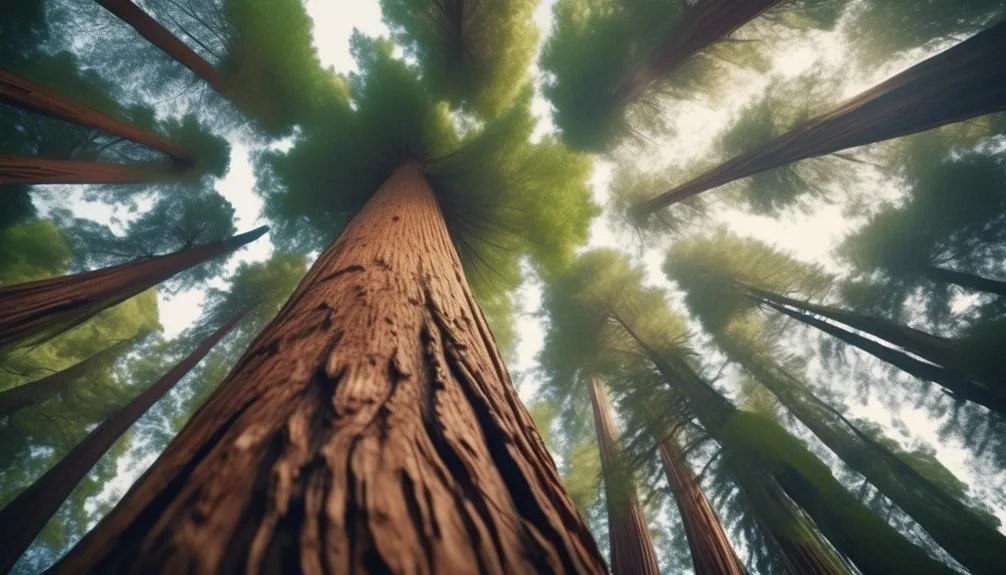Standing in a redwood forest, you're surrounded by towering trees and bustling wildlife. Birds, squirrels, and deer are drawn to these giants for various reasons.
It's not just their size and grandeur that attract animals of all shapes and sizes. Redwood trees have a unique magnetism that entices a diverse array of wildlife.
Height and Canopy
When you stand beneath the towering redwood trees, you can't help but be awed by their impressive height and expansive canopy, which create a breathtaking natural spectacle. These tall trees, reaching heights of over 300 feet, provide an ideal vantage point for wildlife observation.
Their towering presence allows you to witness various bird species, such as owls, hawks, and eagles, as they soar through the forest canopy. Additionally, the dense foliage and towering trunks offer a safe haven for numerous mammals, including deer, squirrels, and raccoons.
The height of the redwoods also creates a unique microclimate, providing shelter and sustenance for diverse flora and fauna. As you gaze up at these majestic giants, you'll understand why they're an integral part of the ecosystem, attracting and supporting a myriad of wildlife.
Abundance of Food
The redwood trees provide an abundant food source for a variety of wildlife, sustaining a diverse array of creatures within their ecosystem.
- The seeds of redwood trees are a crucial food source for many animals, including birds, squirrels, and chipmunks. These animals play a significant role in seed dispersal, as they often bury or cache seeds for later consumption, inadvertently aiding in the distribution and germination of new redwood trees.
- Foraging behavior is commonly observed among wildlife in redwood forests. Squirrels and small rodents spend much of their time foraging for redwood seeds, while birds such as woodpeckers and nuthatches also exhibit foraging behavior, pecking and prying at the trees' bark to uncover insects and larvae.
This behavior not only benefits the wildlife but also contributes to the overall health and regeneration of the redwood forest ecosystem.
Shelter and Nesting Sites
Nestled among the towering redwood trees, the abundance of food sources also provides essential shelter and nesting sites for a diverse range of wildlife species.
The dense canopy and thick foliage of the redwoods create a safe haven for birds, such as owls, hawks, and woodpeckers, which build their nests high above the forest floor.
Additionally, the large, hollowed-out trunks of older redwood trees serve as ideal den sites for mammals like raccoons, squirrels, and bats. These natural shelters not only offer protection from predators but also provide a stable environment for raising young.
The intricate ecosystem supported by the redwood trees allows for fascinating wildlife behavior, making it a prime location for habitat restoration efforts aimed at preserving these vital nesting sites for future generations of wildlife.
Microhabitats and Biodiversity
Amidst the towering redwood trees, a rich tapestry of microhabitats fosters an extraordinary level of biodiversity, creating a thriving ecosystem teeming with a myriad of plant and animal species.
Within this diverse ecosystem:
- Tree Canopy: The upper reaches of the redwood trees provide a habitat for epiphytic plants like mosses and ferns, creating a lush, green canopy that supports a variety of insects and birds.
- *Species Interactions*: Birds, such as warblers and tanagers, find abundant food sources and nesting sites among the branches, while insects contribute to the decomposition of organic matter, enriching the soil.
- *Ecosystem Services*: The canopy also plays a crucial role in regulating the microclimate, reducing temperature extremes and providing shade for understory plants, contributing to the overall health and diversity of the forest ecosystem.
Chemical Signals and Communication
Emanating from the forest floor, a complex network of chemical signals facilitates communication among the diverse array of organisms inhabiting the redwood ecosystem. Redwood trees and the surrounding vegetation release pheromone trails, which serve as olfactory communication channels for various species. These chemical signals are used by insects to locate potential mates, mark territories, and coordinate group activities.
Additionally, the scent cues help small mammals navigate the forest, find food sources, and avoid predators. For example, the Pacific giant salamander uses chemical signals to communicate its reproductive status and establish territory boundaries.
The intricate web of olfactory communication within the redwood ecosystem highlights the interconnectedness of species and the vital role of chemical signaling in sustaining the diverse wildlife population.
Conclusion
In the presence of majestic redwood trees, one can witness the essential role they play in supporting diverse ecosystems by providing food, shelter, and unique microhabitats.
Their ability to attract a wide variety of wildlife enriches the surrounding area, highlighting the vital role these trees play in the natural world.
Mark Hoffman is a dedicated arborist and tree care specialist with over a decade of experience. His love for trees began when he visited Yosemite National Park as a teenager and was awestruck by the giant sequoias. Mark pursued his passion by studying forestry at Michigan Technological University, where he earned a Bachelor of Science degree.
Since then, he has worked tirelessly in the field of arboriculture, helping to preserve and protect trees in his community. His expertise and dedication have made him a respected leader in the industry and a valuable resource for anyone seeking advice on tree care.
